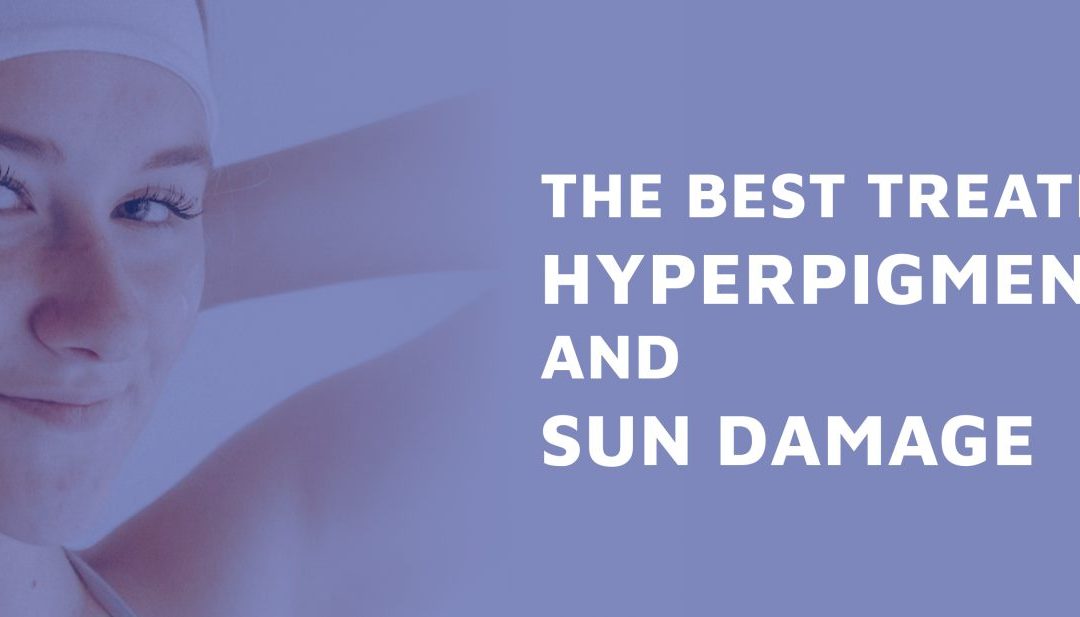Hyperpigmentation appears as either red, pink, brown, black, or gray spots or small patches of discoloration. It can show up anywhere on the body.
Hyperpigmentation is influenced by all types of things, from sun exposure for long periods without sun protection, to hormonal changes, to skin color, to side effects of medication, and simply the body’s natural aging process.
Although it is physically harmless and does not cause pain, hyperpigmentation can cause personal issues for those affected by it. And when you want to treat hyperpigmentation, there are many topical treatments and dermatology procedures that can help, but it’s not always clear how to identify the best treatment options for you. That’s why we wanted to put together this helpful guide. Ready to learn more?
What Causes Hyperpigmentation?
Under normal circumstances, cells known as melanocytes support melanin production, which is what creates your natural skin color. In skin cells with hyperpigmentation, excess melanin is produced, which leads to more color in those cells than normal.
There are several types of hyperpigmentation, each with its own set of considerations from a medical standpoint.
Freckles
Individuals with fair skin are more likely than darker skin individuals to develop freckles, which are actually one of the most common types of hyperpigmentation! Freckles usually develop during childhood, and tend to lighten with less sun exposure or the use of SPF sunscreen.
Sun Spots
Lentigines, the formal name for sun spots, age spots, or liver spots, are a simple product of sunlight. They are flat marks that usually appear as tan, brown, or black. Sun spots are caused by excess melanin, which is produced by skin cells in areas frequently exposed to the sun.
Some people are more susceptible than others, including those with lighter skin tones, people who soak up a lot of UV rays, and anyone over the age of 50. With that being said, you don’t need to be in one of these susceptible groups to develop age spots.
Melasma
Melasma is a term used for patches of skin that are a darker skin tone than a person’s normal skin. These patches are usually flat, but can appear with defined edges that raise slightly. Melasma is more often found in those assigned female at birth. Causes may include birth control medications or pregnancy, and symptoms often subside when the pregnancy ends or birth control medication is ceased. While melasma sometimes goes away on its own, treatments include over-the-counter creams as well as cosmetic procedures to reduce patches of darkness.
Like other forms of hyperpigmentation, melasma is painless and harmless. However, due to the fact that melasma typically forms on the face or other areas exposed to the sun, it can cause self-esteem issues in people who are affected by it, particularly in more severe cases.
Post-Inflammatory Hyperpigmentation
Post-inflammatory hyperpigmentation (PIH) refers to any change in color of the skin following a cut, rash, traumatic injury, acne condition, or inflammatory disease onset, like lupus. People with darker skin are more likely to experience PIH.
Like other forms of hyperpigmentation, PIH is the result of excess melanin production by a set of affected skin cells. However, unlike other forms that mainly affect the epidermis, PIH can also affect a deeper layer of the skin, the dermis. As such, you should certainly speak to a dermatologist if you believe you may have PIH, since they will be best suited to treat your specific condition.
Hyperpigmentation Treatment Options
Similar to how hyperpigmentation has many possible causes, there is a wide range of potential treatments to help fix an uneven skin tone or remove individual dark spots or sun spots. However, there are important considerations to make with any treatment, including potential side effects and downtime following a procedure.
There are several over-the-counter treatments you can use at home to begin treating hyperpigmentation. However, it is best advised that you use these skin care products under the direction of a skin care specialist or physician and avoid any home remedies that may damage your skin more than they help it.
Here are our favorite over-the-counter options:
Vitamin C
Vitamin C is one of the most popular and effective treatments for hyperpigmentation due to its strong antioxidant properties.
Retinoids
Retinol is a specific form of vitamin A that has proven itself to be an effective at-home treatment for hyperpigmentation. Alone, it can reduce dark spots and prevent existing ones from getting darker. It is recommended to start retinol at a younger age due to its anti-aging properties.
RA Therapy Retinol from Zadeh MD Skin includes not only retinoids but also vitamin C and vitamin E with a proprietary Trans-epidermal carrier to maximize the anti-aging benefits and increase cell turnover.
Niacinamide
Otherwise known as vitamin B3, niacinamide is a powerful ingredient known to lighten skin and decrease the presence of hyperpigmentation in as little as 4 weeks.
The Rejuvenation Complex from Zadeh MD Skin uses multiple powerful ingredients, including niacinamide, to deliver results similar to one injection of hyaluronic acid filler in just two weeks.
Effective Treatments For Advanced Hyperpigmentation
For any large, dark sun spots or post-inflammatory hyperpigmentation damage that reaches into the dermis and evades over-the-counter options, options like laser therapy exist to quickly improve the appearance and
Microneedling
Microneedling creates tiny injuries with, as the name suggests, microscopic needles. The result is increased collagen production and cell turnover that quickly reduces the visible appearance of hyperpigmented skin. In addition, it tightens and improves overall skin texture immediately.
Dr. Zadeh uses a revolutionary microneedle device containing 24-karat gold needles thinner than a strand of hair. This allows him to deliver products directly into the dermal layer of the skin with no pain, bruising, or downtime of any kind. Some minor redness can be expected for a couple of hours following the procedure, but you should be able to return to normal activities.
Laser Treatment
Laser resurfacing is a type of light therapy treatment that works incredibly well on a wide variety of skin issues, including hyperpigmentation and other dark spots. The reason it works so well on dark spots particularly, is because the laser breaks down melanin under the skin, leading to a more even skin tone in the applied area.
Best Treatment Options For Sun Damaged Skin

Technically speaking, the best treatment for sun damage is to prevent it with a product every dermatologist recommends: broad-spectrum sunscreen. Zadeh MD Skin offers an SPF 45 broad-spectrum sunscreen that also doubles as a moisturizer!
However, sun damage can also be exacerbated by certain medications, medical conditions, or autoimmune diseases. In some cases, this makes the damage nearly unavoidable.
Once your skin has been UV damaged, SPF can only help prevent further damage, and you may wonder if you can fix sun damaged skin. The good news is that there are many effective treatments to help improve your skin condition, including some we’ve already covered and a new group of chemical peels ready to restore your youthful skin.
Retinoids
Retinol is great to use for sun-damaged skin as well because it improves your skin texture and prevents any further darkening. It is good to know going in that as your skin adjusts to retinoid, there is sometimes a phase where your skin will peel slightly.
Glycolic Acid And Salicylic Acid
Both glycolic acid and salicylic acid have benefits when it comes to treating sun damage. Glycolic acid has been found to have a protective effect against UVB rays, which means it can help prevent photoaging. Salicylic acid works to exfoliate the skin, promoting cell turnover, which can help reduce sun spots over time. Together, these two acids make a great combination.
Zadeh MD Skin knows this, which is why they released the Pore Refining Pads containing both glycolic and salicylic acid with 5% lactic acid. Together, the three compounds work to deliver a gentle chemical peel that helps correct an uneven skin tone quickly.
Kojic Acid
Kojic acid works to inhibit the production of melanin, thus acting as an anti-aging and anti-hyperpigmentation aid. It can also improve discoloration of all forms when used on a regular basis, but it is particularly effective against sun spots and PIH-associated pigmentation.
Hydroquinone
Hydroquinone is the strongest brightening product available. Hydroquinone works by disrupting the tyrosinase enzyme, a key component in melanin synthesis, thereby reducing the skin’s production of melanin, the pigment that determines skin color. It may also cause long-term effects by damaging melanocytes, the cells responsible for melanin production.
Advanced Brightening Pads by Zadeh MD Skin are a great way to not only get your kojic acid, but also a wide range of antioxidant ingredients and skin-soothers that visibly brighten an uneven skin tone. Hydroquinone can also be added to the formula in varying concentrations to help provide maximum brightening.
Not Sure Which Hyperpigmentation Treatment To Choose?
If you want the best results from any treatment, be sure to do your due diligence and look for an experienced physician. You can learn more about Dr. Zadeh’s qualifications by clicking here, or learn more about his approach by clicking here!
Interested in learning more or setting up an appointment? Contact the Z Center for Cosmetic Health today or make an appointment.



